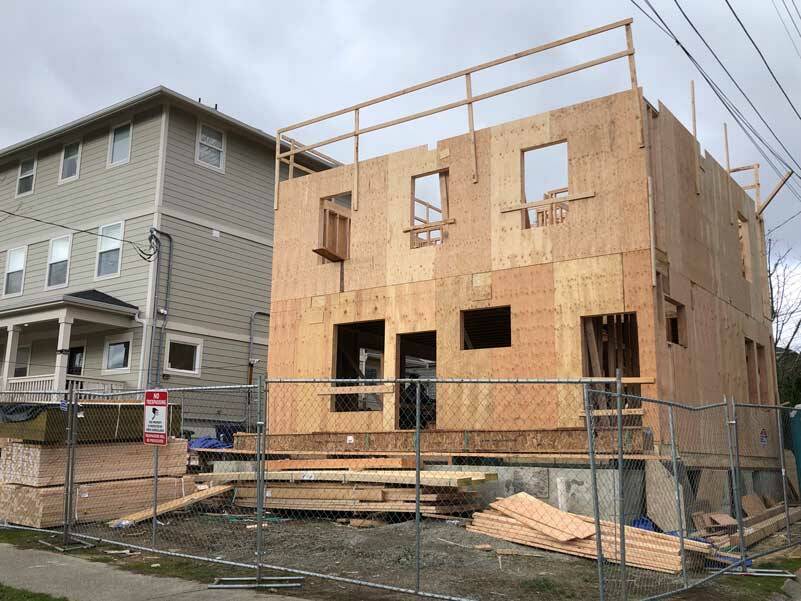By Morf Morford
Tacoma Daily Index
If you’ve been around Tacoma lately, you can’t help noticing building cranes and projects under construction all over the city.
As of February, there are well over 3,000 housing units at some stage of development around the city.
In the standard economic formula, increased supply should reduce the demand, which, in turn should reduce prices.
In 2022, however, traditional economic formulas do not work as they used to.
In Tacoma, and most major cities there are three competing forces that are distorting the once near-sacred law of supply and demand.
First, demand shows no sign of decreasing.
Tacoma, like most urban centers, is attracting new residents at record levels, and those numbers are projected to grow dramatically.
The work from home trend has put economic pressure on areas outside of the usual urban centers.
Second, because of a building boom across many regions, combined with supply chain issues, building materials cost more – in many cases – far more than ever.
And third, cashing in on a construction boom was just too irresistible for hedge funds and other investors.
Hedge funds currently own about one in seven homes across the country, with a far higher percentage in the more desirable/profitable areas.
Add in the unforeseeable, black-swan type variables like a concrete worker strike or weather too hot, too cold or just plain too unpredictable, or truckers unavailable if not unwilling to transport supplies under a variety of conditions, as well as the increasing expense – even sheer unavailability – of labor, both skilled and basic, and you have market forces unhinged from both previously stable “laws” like supply and demand on top of unpredictable market forces, trends and realities like we have never seen before.
Even shifts in interest rates or changes in zoning laws – and, perhaps the wildest wild card of all, a potential war in Europe, all combine to throw off all the plans and market assumptions that seemed so solid just a few months ago,
All of these factors drive up prices.
In the old days, as in almost every other era of human history, there were competing, even contradictory forces at work in the housing market.
We might have had labor shortages, or material shortages or funding (as in home loan rates) problems – but rarely, if ever all three (and even a few more) in motion all at once.
After World War II we saw some of these impacts.
The design scheme many of us know as mid-century modern followed this era of deprivation and shortages. Before the sleek lines and turquoise tones of the later 1950s, scavenging and re-purposing were the benchmarks of housing of the late 1940s and very early 1950s – even to the point of buying used (and bent) nails hammered (literally) back into usable shape.
This was the era before sheetrock or plywood – when shiplap and fully dimensional 2x4s were the only building materials, with no big box hardware stores, and few binding laws or rules regarding building/remodeling permits or standards – especially beyond urban boundaries.
Directly across the street from the house where I grew up, in what was then unincorporated Pierce County, there was a small two bedroom rental home built in this immediate post-war era. It was a very simple and cheap one-level, box-style home.
In the 1990s it was demolished to make room for a larger home. In the process, the demolition crew discovered that the house had no standard studs.
The structure of the house was a series of stacked up railroad ties; they were not attached to each other or to anything – just stacked up as a child might build a toy log house.
External siding and interior plaster made the house look indistinguishable from any others in the neighborhood.
In other words, back then, in search of solid and affordable housing, almost any rules, any skill level, and any materials would do.
We are in similar territory now – when the standard and established rules and expectations no longer apply.
From changes in zoning to new materials (from bamboo to hemp-crete and much more) nothing is the way it once was.
One possible (and partial) solution is 3D printed homes (https://www.pbs.org/newshour/show/can-3d-printing-become-a-solution-for-the-housing-shortage).
3D printed homes are very basic and affordable, go up quickly (about 24 hours) and require very little labor.
They are not elaborate or even terribly appealing – but they are shelter – and for many that is the pressing, maybe even only, consideration.
Our housing crisis is on so many levels now that any, and every, solution is on the table.
No solution, from 3D printed homes to massive apartment blocks to ADUs will be attractive, practical or even welcome from everyone.
The apartments going up around Tacoma – and everywhere else it seems – might provide shelter, but they presume a generation (or more) locked into renting.
Home ownership, for better or worse, is what makes a neighborhood. And as many of us have learned recently, builds generational wealth.
When any building goes up, far more than a building is being built.
After all, are entire neighborhoods of quasi-permanent renters what any of us want?
Housing, and prices, are going up by the day.
How much, and for how long, and to what end, are the recurring questions.






